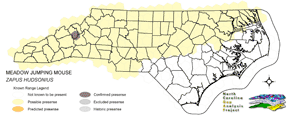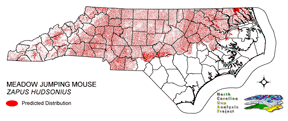
| Taxa: |
| Order: |
| Family: |
| Mammalia |
| Rodentia |
| Dipodidae |
| NatureServe Global Rank: |
| NatureServe State (NC) Rank: |
| G5 |
| S3 |
| Federal Status: |
| NC State Status: |
| --- |
| W2 |


| Land Unit |
| US Fish & Wildlife Service |
| US Forest Service |
| US National Park Service |
| US Department of Defense |
| NC State Parks |
| NC University System |
| NC Wildlife Res. Com. |
| NC Forest Service |
| NC Div. of Coastal Mgmt. |
| Local Governments |
| Non-Governmental Org. |
| Other Public Lands |
| Private Lands |
| GAP Status 1-2 |
| All Protected Lands |
| Statewide |
| Hectares |
| 14,387.85 |
| 24,065.28 |
| 11,285.91 |
| 4,198.95 |
| 12,331.17 |
| 2,650.95 |
| 20,532.60 |
| 510.87 |
| 8.28 |
| 1,454.04 |
| 2,363.04 |
| 1,678.14 |
| 2,507,728.59 |
| 50,033.28 |
| 92,819.64 |
| 2,603,195.67 |
| Acres |
| 35,553.14 |
| 59,466.59 |
| 27,888.09 |
| 10,375.83 |
| 30,470.98 |
| 6,550.64 |
| 50,737.15 |
| 1,751.36 |
| 20.46 |
| 3,593.01 |
| 5,839.20 |
| 4,146.77 |
| 6,196,731.09 |
| 124,123.88 |
| 229,851.25 |
| 6,433,124.31 |
| % of Dist. on |
| Prot. Lands |
| 15.5 % |
| 25.9 % |
| 10.4 % |
| 4.5 % |
| 13.3 % |
| 2.9 % |
| 21.9 % |
| 0.6 % |
| < 0.1 % |
| 2.5 % |
| 2.5 % |
| 1.0 % |
| 0.0 % |
| 53.9 % |
| ----- |
| ----- |
| % of Dist. on |
| All Lands |
| 0.6 % |
| 0.9 % |
| 0.4 % |
| 0.2 % |
| 0.5 % |
| 0.1 % |
| 0.8 % |
| < 0.1 % |
| < 0.1 % |
| < 0.1 % |
| < 0.1 % |
| < 0.1 % |
| 96.3 % |
| 1.9 % |
| ----- |
| ----- |
|
The meadow jumping mouse is rare to uncommon in the mountains and piedmont of North Carolina (Lee et al. 1982). This mouse dwells primarily in open habitats with dense grass or grass and forb cover, but also uses herbaceous growth mixed with shrubs or in forest settings (Whitaker and Hamilton 1998). Moist sites in bogs and fens and along streams as well as dry upland sites are all suitable as habitat provided dense herbaceous vegetation is present. However, in North Carolina, wetter sites are preferred (Lee et al. 1982). Shelter and nesting activity is underground in burrows usually dug in dry fields or in a bank or hillside near wet herbaceous sites (Linzey and Linzey 1971). NATURE SERVE GLOBAL HABITAT COMMENTS: Moist lowland habitats; prefers relatively thick vegetation of open grassy and brushy areas of marshes, meadows, swamps, and streamsides. When inactive, occupies underground burrow, usually in a bank or hill (winter), or under log or grass clump. Young are born in nest underground or under other cover. |
| Code | Name | Description | NC Natural Heritage Program Equivalent |
| 121 | Maritime Pinelands | Loblolly forests and woodlands of the outer coastal plain. | Estuarine Fringe Loblolly Pine Forest |
| 173 | Coastal Plain Riverbank Shrubs | Shrub dominated riverbanks, commonly dominated by willows and/or alders. | Sand and Mud Bar |
| 50 | Coastal Plain Mixed Bottomland Forests | Includes forests dominated by a variety of hardwood species, including sweetgum, cottonwood, red maple. | Coastal Plain Bottomland Hardwood (in part), Coastal Plain Levee Forest |
| 49 | Coastal Plain Oak Bottomland Forest | Bottomland forests dominated by deciduous oak alliances. Oaks represented can include swamp chestnut, cherrybark, willow, and/or overcup oak. Inclusions of loblolly pine temporarily flooded forests occur in patches. Hydrology is temporarily to seasonally flooded. | Coastal Plain Bottomland Hardwoods (in part) blackwater subtype, brownwater subtype |
| 158 | Coastal Plain Nonriverine Wet Flat Forests | Loblolly pine - Atlantic white-cedar - red maple - swamp tupelo saturated forests as well as forests dominated by loblolly, sweetgum, and red maple in non-riverine flats. | Non-riverine Wet Hardwood Forest |
| 41 | Peatland Atlantic White-Cedar Forest | Dense stands of Atlantic white cedar with saturated hydrology. Can include swamp tupelo, red maple, and pond pines with a moderate shrub and herb layer. | Peatland Atlantic White-Cedar Forest |
| 15 | Seepage and Streamhead Swamps | Includes extensive peat flats in the coastal plain, dominated by swamp tupelo, maples, and Atlantic white cedar alliances. In the sandhills includes streamhead pond pine and bay forests alliances. Saturated hydrology. | Bay Forest, Small Depression Pocosin, Streamhead Atlantic White Cedar Forest, Streamhead Pocosins |
| 385 | Oak Bottomland Forest and Swamp Forest | The swamp chestnut oak, cherrybark oak, shumard oak and sweetgum alliance is one representative. Other alliances are dominated by water, willow, and overcup oaks. Swamp forests can be dominated by sweetgum, red maple, and black gum being dominant. Loblolly can occur in combination with sweetgum and red maple, or with tulip poplar. Includes saturated and semi- to permanently flooded forests in the mountains. | Piedmont/Mountain Bottomland Forest, Piedmont/Mountain Swamp Forest |
| 87 | Pocosin Woodlands and Shrublands | Includes pond pine woodland, low pocosin and high pocosin shrub dominated areas. Canebrakes and bay forests may be present. | Pond Pine Woodlands, Peatland Canebrake, Small Depression Pocosin |
| 67 | Wet Longleaf or Slash Pine Savanna | Wet flatwoods and pine savannas, typically dominated by longleaf pines, but slash or pond pines may be the dominant pines. | Wet Pine Flatwoods |
| 97 | Mesic Longleaf Pine | Longleaf pine woodlands without a major scrub oak component. Slash or loblolly pines may be present as well. | Mesic Pine Flatwoods |
| 42 | Xeric Longleaf Pine | Sandhills including a range of longleaf pine density from predominantly wiregrass, scrub oak dominated to true longleaf pine woodland. This does not include mesic or saturated flatwood types. | Xeric Sandhill Scrub, Pine/Scrub Oak Sandhill, Coastal Fringe Sandhill |
| 46 | Xeric Oak - Pine Forests | Mixed forest dominated by yellow pines with white or northern red oaks co-dominating. | Pine Oak Heath |
| 267 | Riverbank Shrublands | Riverside shrubs with temporarily flooded hydrologies. Found in the both the Mountains and Piedmont. Containing dominants such as smooth alder and a Carolina or black willows. | Sand and Mud Bar |
| 269 | Floodplain Wet Shrublands | Saturated shrublands of the Piedmont, includes buttonbush, swamp-loosestrife, decodon and alders. | Piedmont/mountain Semipermanent Impoundment |
| 230 | Piedmont Mesic Forest | American Beech - Red Oak - White Oak Forests. | Mesic Mixed Hardwood |
| 384 | Piedmont/Mountain Mixed Bottomland Hardwood Forests | Includes temporarily to seasonally forests dominated by hardwood species. Hardwoods include sweetgum, red maple, sycamore which co-occur in a mosaic of bottomland and levee positions. Includes alluvial hardwood forests in the mountains. Hemlock and white pine may occur as inclusions, but are generally mapped separately. | Piedmont/Mountain Alluvial Forest, Piedmont/Mountain Levee Forest |
| 383 | Piedmont Mixed Successional Forest | Generally loblolly mixed with successional hardwoods. Sweetgum, tulip poplar and red maple are common co-dominants in these successional forests. | No equivalent |
| 226 | Piedmont Xeric Woodlands | Generally post and blackjack oak dominated woodlands. White ash and pignut hickory can be found in combination with Eastern red cedar on glades. | Xeric Hardpan Forest |
| 20 | Coniferous Regeneration | Regenerating pine stands. Predominantly loblolly pine, but slash and longleaf stands occur as well. | No equivalent |
| 36 | Successional Deciduous Forests | Regenerating deciduous trees with a shrub stature. Commonly dominated by sweetgum, tulip poplars and maples. | No equivalent |
| 205 | Agricultural Pasture/Hay and Natural Herbaceous | Farm fields used for pasture grass or hay production, as well as old fields dominated by native and exotic grasses. | No equivalent |
|
Hafner, D. J., K. E. Petersen, and T. L. Yates. 1981. Evolutionary relationships of jumping mice (genus ZAPUS) of the southwestern United States. J. Mamm. 62:501-512.
Muchlinski, A. E. 1988. Population attributes related to the life-history strategy of hibernating ZAPUS HUDSONIUS. J. Mamm. 69:860-865. Frey, J. K. 1992. Response of a mammalian faunal element to climatic changes. J. Mamm. 73:43-50. U.S. Fish and Wildlife Service (USFWS). 25 March 1997. Proposal to list the Preble's meadow jumping mouse as an endangered species. Federal Register 62:14093-14101. Jones, J. K., Jr., et al. 1992. Revised checklist of North American mammals north of Mexico, 1991. Occas. Pap. Mus., Texas Tech Univ. (146):1-23. Morrison, J. L. 1992. Persistence of the meadow jumping mouse, ZAPUS HUDSONIUS LUTEUS, in New Mexico. Southwest. Nat. 37:308-311. Wilson, D. E., and D. M. Reeder (editors). 1993. Mammal Species of the World:a Taxonomic and Geographic Reference. Second Edition. Smithsonian Institution Press, Washington, DC. xviii + 1206 pp. Whitaker, J.O. Jr. and W.J. Hamilton, Jr. 1998. Mammals of the eastern United States. Cornell Univ. Press, Ithaca, New York. 583 pp. Preble, E. A. 1899. Revision of the jumping mice of the genus Zapus. North American Fauna 15:1-43. Quimby, D.C. 1951. Life history and ecology of the jumping mouse, Zapus hudsonicus. Ecol. Monogr. 21(1):61-95. Lee, D. S., L. B. Funderburg Jr., and M. K. Clark. 1982. A distributional survey of North Carolina mammals. Occasional Papers of the North Carolina Biological Survey, No. 1982-10. North Carolina State. Mus. Nat. Hist., Raleigh, North Carolina. 72 pp. Whitaker, J.O., Jr. 1963. A study of the meadow jumping mouse Zapus hudsonius (Zimmerman), in central New York. Ecol. Monogr., 33(3):215-254. Linzey, Alicia V., & Donald W. Linzey. 1971. Mammals of the Great Smoky Mountains National Park. The University of Ten- nessee Press, Knoxville, Tennessee. 114 p. Whitaker, J.O., and R. E. Wrigley. 1972. ZAPUS HUDSONIUS. Am. Soc. Mamm., Mammalian Species No. 11. 7 pp. Banfield, A.W.F. 1974. The mammals of Canada. University of Toronto Press, Toronto. Godin, A.J. 1977. Wild Mammals of New England. Johns Hopkins University Press, Baltimore. 304 pp. Hamilton, William J., Jr., and John O. Whitaker, Jr. 1979. Mammals of the eastern United States. Cornell Univ. Press, Ithaca, New York. 346 pp. Schwartz, Charles W., and Elizabeth R. Schwartz. 1981. The wild mammals of Missouri. University of Missouri Press, Columbia. 356 pp. Baker, Rollin H. 1983. Michigan mammals. Michigan State University Press. 642 pp. Hoyle, J. A., and R. Boonstra. 1986. Life history traits of the meadow jumping mouse, ZAPUS HUDSONIUS, in southern Ontario. Can. Field-Nat. 100:537-544. Hoffmeister, D. F. 1986. Mammals of Arizona. Univ. Arizona Press and Arizona Game and Fish Dept. 602 pp. |
For more information please contact them at:
NC-GAP Analysis Project
Dept. of Zoology, NCSU
Campus Box 7617
Raleigh, NC 27695-7617
(919) 513-2853
www.basic.ncsu.edu/ncgap